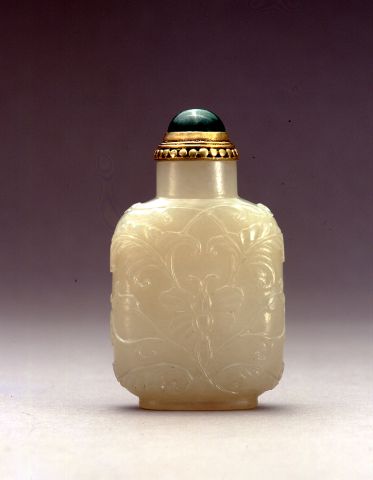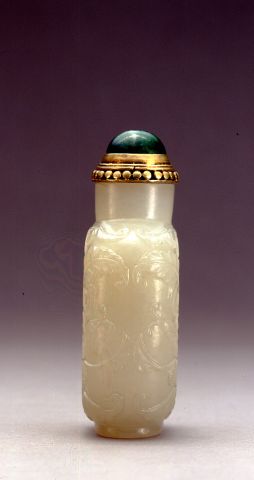

Bottle ID: 283
IMPERIAL, CARVED, MOGHUL STYLE
Date: 1760-1799
Height: 55 mm
Nephrite, pale greenish-white, very well hollowed, of flattened rectangular form with rounded shoulders and a recessed oval foot, carved continuously in low relief with formalized scrolling lotus flower-heads and leafy vines.
Imperial, attributed to the Tibetan Palace Workshops (Xifanzuo), Beijing.
Similar Examples:
Crane Collection no. 172
Hall, Robert. Chinese Snuff Bottles XI, The Snowy Peaks Collection, 2005, no. 87.
Moss, Hugh, Victor Graham and Ka Bo Tsang. A Treasury of Chinese Snuff Bottles - The Mary and George Bloch Collection, 1995, Vol. 1, pp. 280-283, no. 114.
Sotheby's, London, April 24, 1989, lot 101, Collection of Eric Young, Part III.
Provenance:
Hugh Moss [HK] Ltd.
Exhibited:
Annual Convention ICSBS New York, November 2013
This design is a favorite of the Palace Workshops and, indeed, the Qianlong Emperor, and is based on northern Indian lotus motif. In 1759 the Qianlong Emperor conquered the whole of what is now Xinjiang province, including the jade producing regions of the Kunlun mountains, Khotan and Yarkand (Chinese Turkestan). From this time onwards large quantities of raw jade were brought to the Court, together with a number of Northern Indian and Turkish jade carvings which were presented as tributes, intriguing the Emperor to the point of obsession and encouraging him to start a new workshop in the Imperial compound. He called this the Xifanzuo, or Tibetan workshop, Tibet then representing the entire area of Northern India and Tibet. Much of the jade carved in the workshop directly copied the jades the Emperor knew as Hindustani jades, with their fine quality, exaggerated thinness and formalized floral designs, often based on Indian lotus scrolls and acanthus leaf designs. The Tibetan Workshop was one of six new workshops around the country which were set up to cope with the Imperial demand for jade carvings increasing the amount of workshops in the latter part of the Eighteenth century from two (one in Beijing and one at Suzhou), to eight.
< Back to full list

 English
English 中文
中文